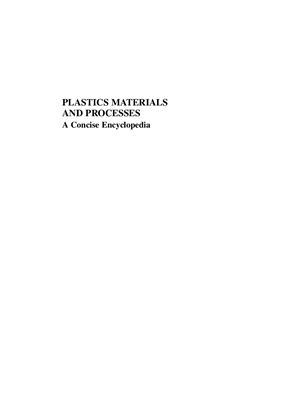Published by John Wiley & Sons, Inc. , Hoboken, New Jersey. 2003. –
988 с.
A Concise Encylopedia defines the important concepts of the plastics industry in a single-volume encyclopedia. Materials, processes, properties, test methods, and other information that is used commonly throughout the industry are defined without great involvement in detail and in a manner that is straightforward and efficient. This book is aimed at meeting the needs of general managers, executives, purchasing and manufacturing personnel, supervisors, engineers, students, and all others that are working in the field of plastics or have interest in these important materials.
The selection of information provided in this book has been made with a view toward giving the reader an efficient, intelligent overall insight without having to wade through voluminous texts or handbooks in specific areas. It is not the purpose of the book to provide an exhaustive treatise on any subject, as it is assumed that the reader will consult more comprehensive and detailed texts, jouals, and even the producers of materials and processing equipment for such specific and indepth information. However, this book should make the jouey to acquire such information easier and more efficient.
As the goal of this book is to provide a sourcebook of practical information for all ranges of interest, its organization is aimed primarily at reader convenience. The main body, therefore, consists of a concise encyclopedia of knowledge useful in today’s plastics industry. It contains an extensive array of materials information and property and performance data presented in an alphabetical format. In addition, it presents all-important application guidelines, process method trade-offs, and design, finishing, and performance criteria. It also summarizes chemical, structural, and other basic polymer considerations.
This main body of information is preceded by a brief introduction to polymers and plastics that may be used to provide the reader with a glue to hold the individual snippets of information together. This initial section covers the nature of polymers, and it offers an introduction to the material and process descriptions that follow.
After the encyclopedia, are several appendices containing valuable property data and other detailed information. Here plastics and other materials commonly used in the industry are compared to one another, and guidance is offered regarding their processing methods and final applications. Finally, there is a completely cross-referenced and easy-to-use index that is provided as a road map for the preceding information and as a method of linking subjects and information together.
The result of this compilation is a concise, yet valuable reference to the broad
amount of information required to function in the plastics industry. It will be a useful
first-source to anyone involved in all aspects of product design, development,
application, manufacturing, marketing, or other peripheral function in the plastics
industry.
A Concise Encylopedia defines the important concepts of the plastics industry in a single-volume encyclopedia. Materials, processes, properties, test methods, and other information that is used commonly throughout the industry are defined without great involvement in detail and in a manner that is straightforward and efficient. This book is aimed at meeting the needs of general managers, executives, purchasing and manufacturing personnel, supervisors, engineers, students, and all others that are working in the field of plastics or have interest in these important materials.
The selection of information provided in this book has been made with a view toward giving the reader an efficient, intelligent overall insight without having to wade through voluminous texts or handbooks in specific areas. It is not the purpose of the book to provide an exhaustive treatise on any subject, as it is assumed that the reader will consult more comprehensive and detailed texts, jouals, and even the producers of materials and processing equipment for such specific and indepth information. However, this book should make the jouey to acquire such information easier and more efficient.
As the goal of this book is to provide a sourcebook of practical information for all ranges of interest, its organization is aimed primarily at reader convenience. The main body, therefore, consists of a concise encyclopedia of knowledge useful in today’s plastics industry. It contains an extensive array of materials information and property and performance data presented in an alphabetical format. In addition, it presents all-important application guidelines, process method trade-offs, and design, finishing, and performance criteria. It also summarizes chemical, structural, and other basic polymer considerations.
This main body of information is preceded by a brief introduction to polymers and plastics that may be used to provide the reader with a glue to hold the individual snippets of information together. This initial section covers the nature of polymers, and it offers an introduction to the material and process descriptions that follow.
After the encyclopedia, are several appendices containing valuable property data and other detailed information. Here plastics and other materials commonly used in the industry are compared to one another, and guidance is offered regarding their processing methods and final applications. Finally, there is a completely cross-referenced and easy-to-use index that is provided as a road map for the preceding information and as a method of linking subjects and information together.
The result of this compilation is a concise, yet valuable reference to the broad
amount of information required to function in the plastics industry. It will be a useful
first-source to anyone involved in all aspects of product design, development,
application, manufacturing, marketing, or other peripheral function in the plastics
industry.

